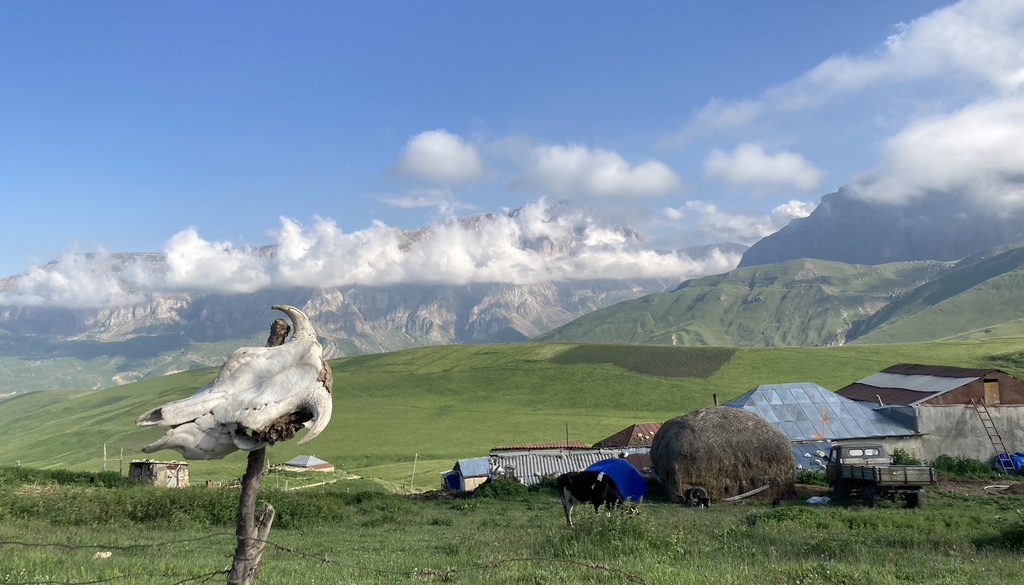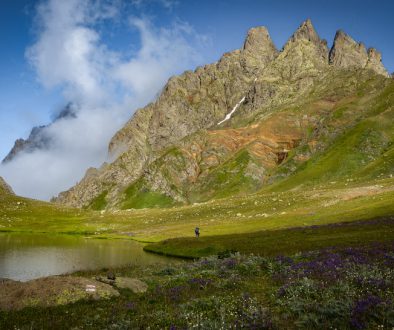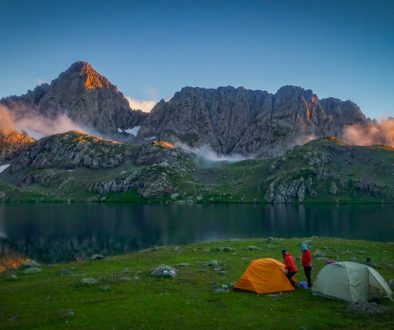Adventures in Azerbaijan: Trekking from Guba to Gusar on the TCT
We are excited to announce the second TCT trail section in Azerbaijan: a 102km trek through the high mountains and deep canyons of the Guba and Gusar regions of Northern Azerbaijan!
The Guba-Gusar trek doesn’t follow a perfectly straight line – instead we’ve pieced together a route that makes sure you don’t miss out on some of the best spots the region has to offer. It follows the trails of shepherds, old caravans, and locals’ routes between settlements. Several sections have already been marked by the Azerbaijan Tourism Board; others are new and unmarked.
The route we’ve chosen to share with you passes settlements that hold fascinating ancient history and several ethnolinguistic indigenous minorities. And, of course, the time spent trekking in between them provides landscapes and experiences nothing short of spectacular.
Along the way, we were hosted by many kind, helpful locals. They all seemed curious about the idea of a trail crossing the Greater Caucasus – but many seemed doubtful that someone would be so crazy as to hike the whole thing. It’ll be up to you all to prove that such crazy folks exist!
We eagerly exchanged stories with these local mountain experts while resting on pillow cushions, drinking countless cups of black tea, and reviving ourselves on homemade fruit preserves. (I highly recommend the white cherry.)
One of our favorite stops along the route is Yergi Kek, one of the highest villages in Azerbaijan at 2,370m elevation. Here, we were welcomed by Elshad and his family, who often host passing hikers in their home. Elshad and his family are Lezgin, an ethnic group native to Dagestan and northern Azerbaijan. They are a proud people who speak their own language and hold an incredibly interesting history that permeates the chronicles of empires of Azerbaijan’s past, both ancient and modern, including Caucasian Albania, Sassanid, Shirvan, and Safavid.
The village of Yergi Kek, given its location and elevation, is very isolated. Elshad’s home offers views of striated cliffs and a peaceful quiet, interrupted by clucking of hens, amidst fresh mountain air. We were treated to local indulgences, such as evellik dolmasi, large sorrel leaves stuffed with lamb and rice, and tskan, a large, buttery pie encasing minced meat, potatoes, and herbs… the definition of Caucasian soul food.
The beginning of the route takes you through the small and entrancing villages of Sohub, Budug, and Zeyid.
Sohub lies under the ruins of an ancient fortress. Underneath the fortress is a series of underground roads connected to the city of Guba, a critical point of military operations centuries ago.
Budug, a village dating back to times of Caucasian Albania, hosts its own ethnolinguistic group, which is related to that of the Griz people. Its isolated location served to protect it from invaders. The caves holding evidence of early human habitation in Budug’s surrounding mountains suggest that humans lived here long before written records.
Zeyid is another ancient, high-altitude, isolated village that lay along an old caravan route. Its people moved locations throughout the area several times under various empires, yet retained their culture and history.
There’s plenty more to be said about the better-known settlements along the Guba-Gusar route, such as Khinalig, Griz, and Galaykhudat. You’ll see more glimpses into these villages on our social media over the next few weeks… But you’ll have to hit the trail for the full experience!
As we hiked between these settlements, it was the natural beauty of the Caucasus that often stopped us in our tracks. Under the bright sun blazing from a cloudless sky, the mountains gleamed a vivid green, colored by wildflowers of every shade. Yards of our hosts teemed with chicks and turkeys and cows against a panorama of green cliffs of folded mountains.
The canyons left us speechless. The green and gray cliffs, underlined by the white and blue Sumur river flowing through the yellow rocks below us, were accessorized by the snowy peak of Shahdag and a double rainbow from the sun.
We passed a seemingly endless extent of hilly green, watched over by a large series of cliffs atop the mountain. For hours, we walked across this field, littered by rocks of all shapes and sizes, plodded by cows lazily munching on the green sod and wildflowers.
Multiple times, we were spurned by angry shepherd dogs protecting their flocks of cattle– only to be welcomed by their shepherds for tea.
The landscapes changed dramatically, especially where the drought hit the worst and scraped much of the once bright and ubiquitous green; but the landscape’s beauty held nonetheless, in its smooth rolling mountains, marvelous canyon, large rock formations, warmth of the residents, and entrancing history.
Trudging through the heat, we’d be overjoyed by a plethora of shade and coolness offered from a hidden cave. Inside, a bustling, noisy waterfall spilled into a cold emerald pool. Just dipping my feet in was rejuvenating.
One afternoon, we passed by a choban (shepherd) settlement of blue tents, next to an apiary of beehives. The men of the settlement were gone for the day, up on high fields tending to the sheep; the women stayed behind with the children, who were taking a break from playing under the sun by resting in the shade of the blue tents. Some kind women took us in and treated us with samovar tea, honeycomb, and fresh lunch.
The women and their families have been living the choban way of life since they first opened their eyes; it’s a lifestyle that’s been passed down for who-knows-how-many generations. In the winter, they retreat to the villages; with the warmer seasons, they return to grassy plateaus.
What we experienced was a sliver of a glimpse into the life and charisma of this eastern range of the Greater Caucasus; and what we received were countless stories, impressions, curiosities, and hopes for the TCT’s future in Azerbaijan.
We can’t wait to hear what you’ll bring back from this newest section of the Transcaucasian Trail… or you can come join us to experience it together this summer on our first supporters’ trek through the region!




























